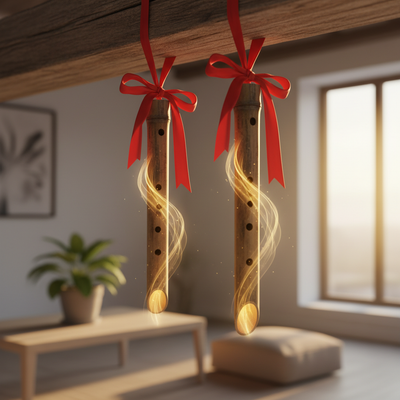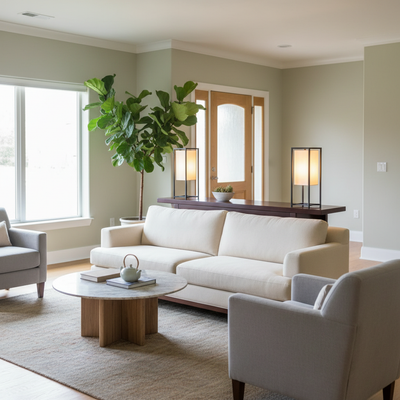Introduction: The Two-Window Problem

If you're standing in your bedroom, looking at two windows and wondering, "Is this bad Feng Shui?", you are asking the right question. Many of our clients come to us with this exact worry, fearing their space has serious problems. Let us tell you right away: a bedroom with two windows is about finding balance, not a major problem. In fact, it has amazing possibilities.
In Feng Shui, we work with Qi (pronounced "chee"), the vital life energy that flows through our surroundings. Windows are considered the "eyes of the home," acting as main doorways for Qi to enter and leave. When you have two windows, the flow of this energy becomes more active. The challenge isn't having two windows, but how the Qi travels between them. A fast, direct, or messy flow can create a space that feels unsettled, possibly affecting your sleep and overall sense of peace. The goal is not to block this energy, but to guide it, slow it down, and balance it to create a supportive and refreshing safe space. This guide will give you the expert rules and practical steps to do just that.
Why Two Windows Are Challenging
The main concern with a two-window layout is that Qi might flow too quickly through the room. Imagine a breeze entering one window and immediately leaving through another without moving around. This creates an "energy tunnel" that can feel disturbing and unstable. This rapid movement is considered Yang energy, which is active and stimulating. While helpful in other parts of the home, too much in the bedroom can disrupt the calm, Yin atmosphere needed for deep rest and renewal. This addresses the underlying fear that the room's energy is working against you, making it hard to relax.
The Hidden Potential
Viewed correctly, two windows are a major advantage. They double the potential for bringing in natural light, improving air flow, and strengthening your connection to the natural world—all of which are highly helpful in Feng Shui. The key is to shift your thinking from seeing a problem to seeing an opportunity. The main principle we teach is that you must manage and balance the Qi, not block it. By understanding the flow and using simple, smart adjustments, you can transform this potential challenge into one of your bedroom's greatest strengths, creating a space that is both bright and balanced, lively and peaceful.
Understanding Basic Principles
To effectively arrange your two-window bedroom, it's helpful to understand the "why" behind Feng Shui recommendations. This knowledge helps you make natural adjustments that feel right for your specific space. The three main concepts at work are Qi, the balance of Yin and Yang, and the influence of direction according to the Bagua map.
Think of Qi as a gentle stream. In a perfect environment, it flows slowly, nourishing everything it touches. Windows and doors are the entry and exit points for this stream. Our goal is to prevent it from becoming a rushing river, which washes away peace, or a still pond, which leads to tiredness. With two windows, you have two powerful channels for this energy, making its management crucial for maintaining a peaceful atmosphere in the room dedicated to rest and renewal.
Windows as Room's Eyes
As the "eyes of the room," windows control how energy and light enter your personal space. When Qi enters through one window and has a direct, clear path to another window or the bedroom door, it moves too quickly. This rapid movement doesn't allow the energy to circulate and nourish the room. This is particularly problematic if your bed is situated within this direct line of energy, as it can lead to restless sleep and a feeling of being drained rather than recharged in the morning. The first step in any analysis is to identify these primary energy pathways.
The Bedroom's Yin Energy
Every space has a main energy. The bedroom is basically a Yin space. Yin energy is passive, quiet, dark, and restorative. It's the energy of the moon, of stillness, and of deep rest. Yang energy, by contrast, is active, bright, and loud—the energy of the sun and daytime activities. While a healthy home needs a balance of both, the bedroom should always favor Yin. Two large windows can introduce too much Yang energy through light and active Qi flow. This disrupts the restful Yin atmosphere, making it harder to unwind and achieve deep, restorative sleep. The solutions we provide are all aimed at reducing this Yang influence, especially during the evening and night.
| Yin Energy (Rest) | Yang Energy (Activity) |
|---|---|
| Quiet, Stillness | Movement, Sound |
| Darkness, Dim Light | Bright Light, Sunlight |
| Soft Textures, Curves | Hard Surfaces, Straight Lines |
| Cool Colors (Blues, Blacks) | Warm Colors (Reds, Oranges) |
| Associated with Night, Rest | Associated with Day, Action |
| Goal in Bedroom: Main | Goal in Bedroom: Balanced/Reduced |
Introducing the Bagua
The Bagua is an energy map used in Feng Shui that divides a space into nine areas, each matching a different aspect of life (e.g., wealth, health, relationships) and a specific compass direction. While a deep dive is complex, the essential concept for our purpose is that the direction your windows face matters. A window in the North brings in energy related to your career path, while a window in the East connects to new beginnings and family. This is why a one-size-fits-all solution is rarely effective. The window's location on the Bagua map influences the specific type of energy it brings into your bedroom, a crucial detail we will explore further, particularly concerning the nan (South) direction.
Analyzing Your Layout
The physical placement of your two windows is the most critical factor in determining the flow of Qi. General advice often fails because it doesn't account for these specific building details. At our consultancy, we always begin by mapping the room. Here, we'll analyze the three most common two-window setups, explaining the energetic challenge and the main solution for each. This will allow you to identify your layout and receive tailored, actionable insights.
Configuration 1: Opposite Walls
This is the most challenging layout, often called the "energy tunnel" or "river of Qi." When windows are directly opposite each other, energy enters one and shoots straight out the other, creating a swift current through the middle of the room.
The Challenge: This rapid Qi flow creates a highly unstable and restless environment. If your bed is placed anywhere in this central path, it can lead to significant sleep problems, anxiety, and a persistent feeling of being unsettled. The energy doesn't have a chance to move slowly and nourish the space; it simply passes through, taking any sense of calm with it. People sleeping in this setup often report feeling drained, as if their own energy is being pulled out of the room.
The Main Solution: The primary goal is to slow down and break up this direct line of energy. This is achieved by placing a "cure" or an obstacle in the path of the Qi. A faceted crystal ball hung in one of the windows can spread the incoming energy into a rainbow of softer light. A tall, leafy plant, a delicate screen, or even a strategically placed armchair can act as a buffer, forcing the Qi to slow down and circulate more gently around the room. The key is to interrupt the direct line without completely blocking the light or view.
Configuration 2: Adjacent Walls
When two windows are located on adjacent walls, meeting in a corner, they create a different kind of energetic pattern. This layout is generally more favorable than opposite walls, but it still requires mindful arrangement.
The Challenge: The energy flow in this setup can feel like it's "cutting" across the corner of the room. This can create an uneven distribution of Qi, with one part of the room feeling more active or agitated than the rest. If the bed is positioned facing this corner, it can create a subtle sense of pressure or unease. The corner itself can become a whirlpool of competing energies, which can feel jarring depending on its location within the room's Bagua.
The Main Solution: The focus here is on softening and balancing the corner where the two energy flows meet. A large plant with soft, rounded leaves placed in the corner is an excellent cure. It absorbs any sharp or "cutting" energy and lifts it, promoting a more gentle circulation. Another effective solution is to place a floor lamp in the corner to lift the energy with light. Alternatively, a comfortable reading chair and a small table can transform the corner into a stable, inviting nook, effectively grounding the energy.
Configuration 3: Same Wall
This is often the most favorable of the three common layouts. Having two windows on the same wall means there is no direct opposition creating a fast-moving current of Qi. The energy enters and circulates more naturally.
The Challenge: While generally positive, this layout can create a strong imbalance of energy. The wall with the windows becomes very Yang (active, bright), while the opposite wall can feel comparatively Yin (dark, heavy, stagnant). This can make the room feel lopsided. If the bed is placed against the opposite, solid wall (which is often ideal), the intense energy from the two windows can still feel overwhelming as you try to rest.

The Main Solution: The goal is to create balance across the entire room. Anchor the wall opposite the windows with a substantial piece of furniture, such as a long dresser, or a significant piece of art to give it more "weight." Use mirrors thoughtfully on one of the side walls to reflect light and distribute the energy from the windows more evenly throughout the space. For the window wall itself, a single, long curtain rod that spans both windows can visually unite them, creating a more unified and less "busy" energetic statement. This helps treat them as one harmonious feature rather than two separate, active portals.
The 'Nan' (South) Factor
In Feng Shui, direction is not just a geographical marker; it's a source of specific elemental energy. When analyzing a bedroom with two windows, factoring in the compass direction adds a layer of expert insight that is crucial for true balance. This is especially true for a room facing nan, the Chinese word for South.
A south-facing bedroom with two windows presents a unique and powerful scenario. According to the principles of Compass School Feng Shui, the South direction is naturally linked to the Fire element. This element governs your reputation, passion, recognition, and social life. Having two windows in a nan-facing room means you have two large portals amplifying this intense Fire energy. This can be a double-edged sword, bringing either vibrant success or exhausting burnout, depending on how it is managed.
The Power of 'Nan'
The Fire energy of the South is potent and dynamic. When balanced, it can fill your life with passion, visibility, and vibrant social connections. It can fuel creativity and help you gain recognition in your career and community. A nan-facing bedroom can be wonderful for someone looking to increase their public profile or bring more excitement into their life.
However, too much Fire energy, amplified by two windows, can quickly become overwhelming. This can show up as:
- Overstimulation and restlessness, making sleep difficult.
- A tendency towards arguments, irritability, and emotional instability.
- Feelings of burnout, as the intense energy depletes your personal reserves.
- A space that feels hot, agitated, and far from the peaceful sanctuary a bedroom should be.
Balancing the Fire
For a nan-facing two-window room, the primary goal is to cool and ground the excessive Fire energy. This is achieved by introducing the elements that control Fire in the Five Element cycle: Water and Earth.
Water element cures are essential. This doesn't necessarily mean a fountain. You can introduce Water through colors like deep blues and blacks in your decor, bedding, or artwork. An image of a calm lake or peaceful ocean can be a powerful symbolic cure.
Earth element cures provide stability and grounding. Introduce earthy tones such as soft yellows, beiges, and browns. Materials like ceramic pots for plants, heavy pottery, and natural stone objects help to absorb the excess Fire and anchor the room's energy.
Most importantly, effective window treatments are absolutely necessary. Use heavy, opaque curtains in earthy or watery colors. These allow you to physically block the intense Yang energy of the southern sun during the day if needed, and crucially, to create a dark, Yin environment for sleep at night. Sheer inner curtains can be used to soften the light during the day, but a heavy outer layer is key to controlling the Fire.
A Real-World Solution
Theory is essential, but seeing principles in action provides true clarity. At THE QI FLOW, we believe in real results. A recent project perfectly shows how to transform a challenging feng shui bedroom layout with two windows, particularly one with the added intensity of a nan (South) orientation.
Our client, a marketing executive named Sarah, contacted us feeling constantly exhausted. "I'm a high-energy person," she explained, "but my bedroom feels like it's fighting me. I toss and turn all night and wake up feeling more tired than when I went to bed. It's affecting my work and my mood." She described her bedroom as bright and sunny, a feature she once loved but now found irritating.
The Client's Challenge
Upon visiting, we immediately identified the main issues. Sarah's bedroom was on the top floor, facing due South (nan), with two large windows on opposite walls. Her bed was placed directly in the "energy tunnel" between them. The room was decorated in whites, creams, and a few bright red accents—a combination that was pouring gasoline on an already raging Fire. She was sleeping in the path of a high-speed current of amplified Fire energy. It was no wonder she felt anxious and depleted.
Our Analysis
Our team's diagnosis was clear. The layout created a rapid Qi flow that prevented rest, while the nan direction supercharged this flow with excessive Fire element energy. The light-colored decor and red accents were further intensifying this imbalance. Sarah's personal energy was being constantly drained by her environment. Our objective was twofold: first, to slow the Qi, and second, to cool the elemental imbalance by introducing Water and Earth elements.
The Transformation
We implemented a series of strategic, multi-layered cures:
-
Bed Repositioning: The first and most critical change was moving the bed out of the direct line of energy. We placed it against the solid East wall, putting it in a command position where she could see the door but wasn't directly in line with it. This immediately provided a sense of stability and safety.
-
Slowing the Qi: To break up the energy tunnel, we placed a tall, lush Fiddle Leaf Fig plant near the west-facing window. Its height and large, soft leaves gently interrupt and lift the Qi, encouraging it to circulate. In the east-facing window, we hung a multi-faceted crystal sphere to disperse the incoming morning light into gentle, positive energy.
-
Elemental Balancing: We advised Sarah to replace her red accent pillows with ones in deep navy blue (Water element) and sandy beige (Earth element). We also suggested a large piece of art for the wall opposite her bed—a peaceful, abstract landscape dominated by blues and earthy browns. A beautiful ceramic lamp (Earth element) was placed on her nightstand.
-
Window Treatments: We recommended double-layered curtains. A light, sheer white layer for daytime to soften the southern light, and heavy, blackout-lined curtains in a deep indigo blue (Water element) to create a dark, Yin cocoon for sleeping.
The Result
The change was profound. Two weeks after implementing the changes, Sarah called us.
"I cannot believe the difference. The first night, I slept through until my alarm for the first time in months. The room feels... calm. Before the changes, I always felt on edge in my own bedroom. Now, it's my sanctuary. The difference is night and day."
By analyzing the specific layout and its directional influences, THE QI FLOW team was able to provide targeted solutions that turned a source of stress into a haven of deep rest and renewal.
Your Practical Toolkit
Understanding the principles is the first step; applying them is how you create real change. This section is your practical, hands-on guide to cures and improvements for any two-window bedroom. These are the tools we use to balance our clients' spaces, broken down into actionable steps you can implement right away.
The Foundation: Bed Placement
Where you sleep is the single most important factor in bedroom Feng Shui. Get this right, and everything else becomes easier.
- The Command Position: Ideally, your bed should be placed so that you can see the door without being directly in line with it. This puts you in a position of "command," which promotes a sense of security and reduces unconscious anxiety.
- Avoid the Cross-Current: Never place your bed in the direct line of energy flowing between two windows or between a window and the door. If space is limited and this is unavoidable, ensure you have a very solid, high headboard to provide a buffer and symbolic support.
- Solid Support: Your bed should always be against a solid wall. Avoid placing a bed with the headboard floating in the middle of the room or directly under a window, as this creates a lack of support and stability that can translate to your life.
Mastering Light and Energy
Window treatments are not just decorative; they are powerful tools for managing Qi and balancing Yin/Yang energy.
- Layered Curtains: This is our most frequently recommended solution. Install a double curtain rod. Use a light, sheer layer to soften harsh sunlight and allow soft light to enter during the day. Use a heavy, opaque outer layer (like blackout curtains) to completely block light and outside energy at night, creating the deep Yin environment necessary for restorative sleep.
- Color Choices: The color of your curtains can be used as an elemental cure. For a nan (South) facing room with too much Fire, choose blue, black, or gray (Water) or earthy tones (Earth). For a North (Water) facing room that feels too cold, you might use warmer tones.
Strategic "Cures" for Qi
"Cures" are objects that adjust or redirect the flow of energy in a space. They are the acupuncturist's needles for your home.
- Crystal Power: A multi-faceted, spherical crystal (often sold as a "Feng Shui crystal ball") hung in the center of a window is a classic cure. It catches fast-moving Qi and refracts it, breaking it up and dispersing it as a rainbow of soft, positive energy throughout the room. This is especially effective for interrupting the "energy tunnel" in an opposite-wall layout.
- The Role of Plants: Living plants bring vibrant life force energy into a room. To slow and soften Qi, choose plants with soft, rounded leaves, such as a Jade Plant, Rubber Plant, or Money Tree. Tall plants like a Fiddle Leaf Fig or a Kentia Palm are excellent for placing in corners or between windows to gently guide energy flow.
- Furniture as Anchors: Don't underestimate the power of your furniture. A heavy, solid object like a dresser, a bookshelf, or a comfortable armchair placed between two windows on the same wall can "anchor" the energy, preventing it from feeling too flighty. This adds a sense of stability and substance to the wall.
Do's and Don'ts
For quick reference, here is a summary of the key actions to take and avoid in a two-window bedroom.
| Do | Don't |
|---|---|
| Use a solid, high headboard against a solid wall. | Sleep directly under a window or in a line between two windows. |
| Use layered curtains for light and energy control. | Leave windows bare, especially at night. |
| Place a plant or crystal to slow and soften Qi flow. | Place your bed with your feet pointing directly out the door. |
| Anchor the space with substantial furniture. | Use too many mirrors, which can over-activate the energy. |
| Balance the room's elements with color and materials. | Decorate with overly aggressive or disturbing artwork. |
Conclusion: Creating a Sanctuary
Navigating the energetics of a feng shui bedroom layout with two windows is not about following a rigid set of superstitious rules. It is a practice of mindful observation and intentional balancing. As we have explored, a bedroom with two windows is not an inherent flaw but an opportunity to consciously cultivate a specific kind of energy in your most personal space. The main principle is simple: manage the flow of Qi to create a predominantly Yin environment that supports deep, restorative rest.
Whether you are slowing an energy tunnel, softening a corner, or cooling the Fire energy of a nan-facing room, each adjustment is a step toward transforming your bedroom from a simple place of sleep into a true personal sanctuary. You now have the foundational knowledge and the practical toolkit to make meaningful changes.
Your Bedroom, Your Energy
Remember that the ultimate goal is to create a space that feels supportive and calming to you. We have provided the expert principles and proven techniques, but your intuition is also a powerful guide. Pay attention to how the room feels as you make changes. The best Feng Shui solutions are not only technically correct but also resonate on a personal level. Trust your senses. Your bedroom should be the one place in the world where you can fully relax, recharge, and feel completely at peace.
A Final Team Word
Our work at THE QI FLOW is dedicated to helping individuals create environments that nourish and sustain them. We have seen time and again how a few strategic shifts can have a profound impact on well-being. With the principles outlined in this guide, you are well-equipped to turn any challenging layout into a source of positive energy and profound rest. Your harmonious sanctuary is within reach.







